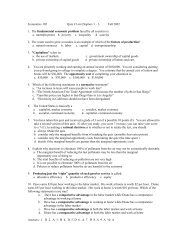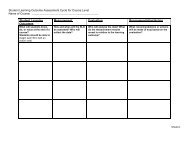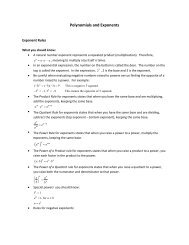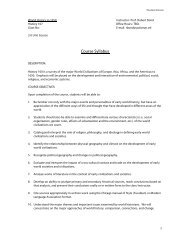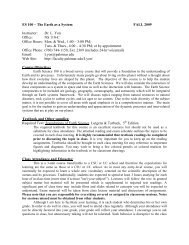Developing Interactive Lectures Using Active ... - Palomar College
Developing Interactive Lectures Using Active ... - Palomar College
Developing Interactive Lectures Using Active ... - Palomar College
You also want an ePaper? Increase the reach of your titles
YUMPU automatically turns print PDFs into web optimized ePapers that Google loves.
On the Cutting Edge Teaching Oceanography Workshop<br />
San Francisco City <strong>College</strong>, San Francisco CA July 2013<br />
<strong>Developing</strong> <strong>Interactive</strong><br />
<strong>Lectures</strong> <strong>Using</strong> <strong>Active</strong><br />
Learning Techniques<br />
Al Trujillo<br />
Department of Earth, Space, & Aviation Sciences<br />
<strong>Palomar</strong> <strong>College</strong> San Marcos CA<br />
atrujillo@palomar.edu<br />
Presentation available at:<br />
http://www2.palomar.edu/users/atrujillo/
Comparing Traditional vs.<br />
<strong>Active</strong> Learning Classrooms<br />
Traditional Classroom <strong>Active</strong> Learning Classroom<br />
• Passive students • <strong>Active</strong> students<br />
• Quiet • Noisy<br />
• Instructor-focused • Student-focused<br />
• Information is conveyed from<br />
instructor to student<br />
• Information passes from student<br />
to student (peer instruction)<br />
• Students work as individuals • Student collaborate<br />
• Competitive learning<br />
environment<br />
• Limited assessment<br />
opportunities<br />
• Supportive learning environment<br />
• Multiple assessment<br />
opportunities<br />
http://serc.carleton.edu/introgeo/interactive/howto.html
Why Use <strong>Active</strong> Learning<br />
• Numerous studies indicate that students learn<br />
better and achieve higher assessment scores of<br />
key concepts through active learning*<br />
• Addresses various student<br />
learning modes<br />
• Students consider active<br />
learning “fun” and<br />
“interesting”<br />
*Sources:<br />
• Science Education Resource Center (SERC) at Carlton <strong>College</strong><br />
http://serc.carleton.edu/introgeo/interactive/why.html<br />
• National Association of Geoscience Teachers (NAGT) Journal of Geoscience<br />
Education (various articles) http://nagt.org/index.html
<strong>Interactive</strong> <strong>Lectures</strong> <strong>Using</strong> <strong>Active</strong><br />
Learning: How It Works<br />
• Lecture is broken into<br />
short segments, separated<br />
by assessments (activities)<br />
• Students share their work<br />
with others in class<br />
• Activities include lecture tutorials, worksheets,<br />
analysis of graphics, group projects, etc.<br />
• Formative exercises during class are used to<br />
assess student understanding and progress<br />
http://serc.carleton.edu/introgeo/interactive/howto.html
<strong>Active</strong> Learning: A Few Caveats<br />
• You give up some control of your<br />
classroom (comfort level)<br />
• Suggestion: Don’t be afraid try new<br />
techniques, especially for topics you<br />
know your students aren’t getting<br />
• <strong>Active</strong> learning can consume large<br />
amounts of class time, so you might<br />
not be able to cover as much content<br />
• Suggestion: Strive for less content<br />
but deeper understanding of the<br />
topics that are covered
Demonstration of Selected<br />
<strong>Active</strong> Learning Techniques<br />
1. Think-pair-share<br />
2. Conceptests<br />
3. Working with real data<br />
4. Predictive demonstrations<br />
5. Muddiest point exercise<br />
6. Question of the day<br />
7. Wall walk<br />
8. Visualizations/Animations Fill your toolbox!<br />
9. Lecture tutorials/Group work<br />
10. Other techniques
1. Think-Pair-Share<br />
• Instructor poses a question and allows students<br />
to make individual responses (with time limit)<br />
• Students then work in pairs (or, if need be,<br />
trios) to discuss answers<br />
• Instructor asks for responses<br />
as report-out to class<br />
• Instructor can use responses<br />
to assess student (mis)understanding<br />
and progress
1. Think-Pair-Share: An Example<br />
Answer on an index card:<br />
• What 5 specific topics do you<br />
think are the most important for<br />
your introductory oceanography<br />
students to learn<br />
SERC’s Think-Pair-Share Page: http://serc.carleton.edu/introgeo/interactive/tpshare.html
1. Think-Pair-Share: Why It Works<br />
• Every student thinks about the question<br />
• By verbalizing it with a partner, they get either<br />
verification or a correction to their answer<br />
• Much more willing to share<br />
with the class once they’ve<br />
discussed their answer with<br />
another student (“low-risk”<br />
leaning environment)<br />
• Promotes student interaction<br />
throughout the semester
2. Conceptests<br />
• Students individually consider a question<br />
related to a prediction, image, or graph<br />
• Students write a response or select an answer<br />
• Can often be combined as a Think-Pair-Share<br />
activity or small group work<br />
• Can be either low-tech or<br />
high-tech<br />
• Use ABCD Handout
2. Conceptest: An Example<br />
Examining the diagram to the<br />
right, which of the following<br />
statements is true<br />
A. Curve A shows a pycnocline<br />
B. Curve A shows a thermocline<br />
C. Curve A represents high latitudes<br />
D. Curve A represents low latitudes<br />
E. None of the above<br />
Think-Pair Share: http://serc.carleton.edu/introgeo/interactive/tpshare.html
2. Conceptests: Options<br />
• Can use a compelling essay questions to<br />
stimulate group discussion (Small group work)<br />
• Can use voting cards, show of hands, online<br />
polling (www.polleverywhere.com) or use PRS<br />
“clickers” as polling devices
2. Best Practices: Conceptest Questions<br />
• Focus on a single concept<br />
• Do not require calculations<br />
• Have good multiple-choice answers that<br />
include misconceptions<br />
• Are clearly worded (short on text)<br />
• Recast concept in a way not covered directly in<br />
lecture<br />
Refs: McConnell and Steer et al. 2006 <strong>Using</strong> ConcepTests to Assess and Improve Student<br />
Conceptual Understanding in Introductory Geoscience Courses. Journal of Geoscience<br />
Education v.54 #1 p.61.<br />
SERC’s ConcepTest Page at: http://serc.carleton.edu/sp/library/conceptests/index.html
3. Working with Real Data<br />
• Brings realism to your classroom<br />
• Allows students to make their own<br />
observations and notice trends<br />
• Make sure the data ties into classroom topics<br />
but isn’t too complex<br />
• Warning: Students may have difficulty filtering<br />
data as scientists do!
3. Working with Real Data: An Example<br />
Q: Is sea level really level<br />
Measuring sea<br />
level from space:<br />
How the TOPEX-<br />
Poseidon satellite<br />
works <br />
Let’s look at<br />
some real<br />
data and do<br />
real science…<br />
Ref: Maury Project: Sea Level Measurement, © American Meteorological Society
3. Working with Real Data: An Example<br />
Note: it’s<br />
the shape<br />
of the sea<br />
floor that<br />
affects sea<br />
level<br />
Q: Is sea level really level NO!<br />
Here’s why:<br />
More mass =<br />
more gravity<br />
Shallow areas =<br />
more rock (less<br />
water) = more<br />
mass beneath =<br />
more gravity, so<br />
seawater piles up<br />
there<br />
Ref: Trujillo and Thurman, Essentials of Oceanography 11 th Edition, © 2014 Pearson Education Pubs., Fig. 3.4
4. Predictive Demonstrations<br />
Normal demo:<br />
• Show and tell<br />
• Students<br />
observing but<br />
not necessarily<br />
engaged<br />
Predictive demo:<br />
• Show and tell, but<br />
students predict<br />
results<br />
• Students active<br />
• Student responses<br />
help address<br />
misconceptions
4. Predictive Demos: An Example<br />
• “Floatability” of diet Coke vs. regular Coke<br />
• Relates to how water masses are formed in<br />
the ocean
4. Predictive Demos: Best Practices<br />
• Relate to class topics<br />
• Use common items to enhance<br />
student interest (esp. food)<br />
• Can be used in large or small<br />
classes<br />
• Can be used with think-pairshare<br />
• Can be enlarged to be a guided<br />
discovery lab<br />
• “Showmanship” encouraged!<br />
Simulated volcanic<br />
eruption using liquid<br />
nitrogen at <strong>Palomar</strong><br />
<strong>College</strong>
5. Muddiest Point Exercise<br />
Ex: “What aspect of today’s class did you<br />
least understand”<br />
• Promotes metacognition<br />
• Involves students in their own learning<br />
• Provides a low-stakes method for students to<br />
interact with their instructor<br />
• Reveals class-wide trends<br />
• Provides a natural starting point for the next<br />
class meeting
Examples<br />
6. Question of the Day<br />
Short activities for the beginning of class<br />
that engage students with lecture material<br />
• You are at the beach and notice that the<br />
tide has come in. Is this a law, theory,<br />
observation, or hypothesis<br />
• What would you do if you were driving and<br />
saw somebody throw their cigarette butt<br />
out the window from a car in front of you<br />
• Review from last class: What are differences<br />
between an island arc and a hotspot
7. Wall Walk<br />
Students respond to statements<br />
• Stimulates class discussions<br />
• Place signs on 4 walls of the class: Agree,<br />
Disagree, Strongly Agree, Strongly<br />
Disagree<br />
• Establish rules (can change where you are<br />
standing, be courteous, raise hand, will be<br />
called upon, etc.; see Rules for…Wall Walk)<br />
• Project a statement about a topic to the<br />
class
7. Wall Walk: Best Practices<br />
• Controversial topics work well<br />
• Assign background readings about<br />
the topic beforehand<br />
• Do not let students stand in the<br />
middle (make them “take a stand”)<br />
• Instructor serves only as a<br />
moderator to encourage<br />
participation/clarify misconceptions
7. Wall Walk: Some Example Q’s<br />
• Instead of dumping harmful pollution in<br />
the ocean, we should dump it on land.<br />
• It is a good idea to add iron to the ocean<br />
to reduce the atmosphere’s greenhouse<br />
effect.<br />
• Scientific theories are never that certain<br />
and so they should not be believed.<br />
• We must protect the ocean by limiting<br />
the harvesting of marine fish.
8. Lecture Tutorials<br />
• Tutorials covering<br />
concepts and<br />
misconceptions<br />
for students to<br />
work on in class<br />
after a short<br />
lecture<br />
• Can be done<br />
individually or in<br />
small groups<br />
Ref: Kortz and Smay,<br />
Lecture Tutorials for<br />
Introductory Geoscience,<br />
© 2010, W. H. Freeman
9. Visualizations/Animations<br />
Visualizations/animations help students<br />
understand important concepts and processes<br />
• Usually need to be shown multiple times and<br />
narrated<br />
• Animations helps students visualize how<br />
oceanographic processes work<br />
• Allows misconceptions to be addressed<br />
• Excellent teaching aid<br />
• Can be associated with worksheets
9. Visualizations/Animations<br />
Ref: Trujillo and Thurman, Essentials of Oceanography 11 th Edition, © 2014 Pearson Education
Your Turn to Come Up With an<br />
<strong>Active</strong> Learning Classroom Activity<br />
• On an index card, write down your idea for<br />
an active learning activity that can be applied<br />
to an important topic that is covered in your<br />
introductory oceanography class (3 minutes)<br />
• Share with others: Hand-up, Stand-up<br />
• Report-out and analysis
10. Other Technique: Jigsaw<br />
Activity<br />
• Students work<br />
cooperatively in small<br />
groups to share data or<br />
different pieces of a puzzle<br />
• Students must rely on each<br />
other to complete the<br />
assignment
10. Other Technique: Concept Maps<br />
• A concept map<br />
is a graphical<br />
tool for<br />
organizing and<br />
representing<br />
knowledge<br />
• Shows the<br />
relationships<br />
among<br />
concepts<br />
Ex: Complete the above concept map<br />
about weathering by selecting the<br />
correct term for the missing boxes #1-5
10. Other Technique: Role Playing<br />
• Students<br />
analyze a<br />
scenario and<br />
recommend<br />
specific<br />
courses of<br />
action<br />
consistent<br />
with scientific<br />
information<br />
Q: Which city should get earthquake<br />
preparedness funding and why
10. Other Technique: Case Studies<br />
• Students<br />
analyze<br />
different<br />
character’s<br />
ideas and<br />
rank them<br />
from “most<br />
feasible” to<br />
“least<br />
feasible”
For More Information…<br />
The SERC Carlton site on <strong>Interactive</strong> <strong>Lectures</strong>:<br />
http://serc.carleton.edu/introgeo/interactive/index.html
<strong>Developing</strong> <strong>Interactive</strong><br />
<strong>Lectures</strong> <strong>Using</strong> <strong>Active</strong><br />
Learning Techniques<br />
Al Trujillo<br />
Department of Earth, Space, & Aviation Sciences<br />
<strong>Palomar</strong> <strong>College</strong> San Marcos CA atrujillo@palomar.edu<br />
Presentation available at: http://www2.palomar.edu/users/atrujillo/<br />
with special thanks to<br />
David Steer, Department of Geology & Environmental Sciences The<br />
University of Akron OH<br />
On the Cutting Edge Teaching Oceanography Workshop<br />
San Francisco City <strong>College</strong>, San Francisco CA July 2013



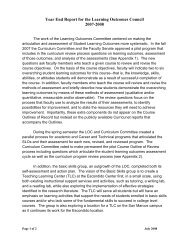

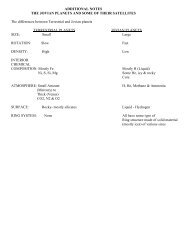
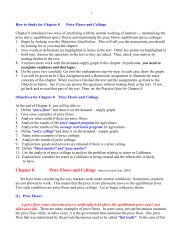
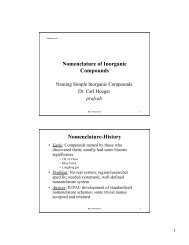
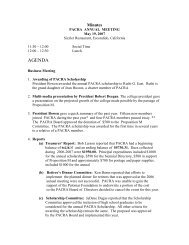
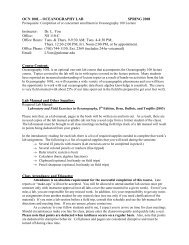
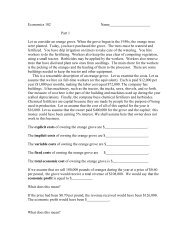
![Ch. 3 [pdf]](https://img.yumpu.com/49528659/1/190x245/ch-3-pdf.jpg?quality=85)
